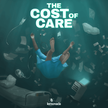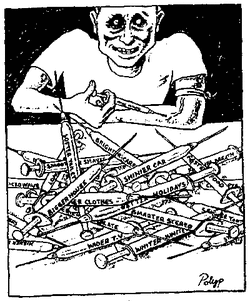|
Hard to believe it's been over a year since the last post. During the break, I channeled my pandemic-related angst into kitchen projects. I learned how to bake with sourdough, tried scores of new recipes, and enjoyed leaving goodies on the doorsteps of neighbors and friends. I learned that sharing home-baked treats with loved ones is a surefire way to reclaim joy. I also spent a lot of time thinking about the ways in COVID has exposed the brokenness our systems and institutions: government, policing, education, and, of course, healthcare. It was the latter that inspired a conversation with the producer of a wonderful new podcast called "The Cost Of Care" The conversation is featured in episode 5, which is called "Burnout: The Vicious Cycle." The Cost of Care takes an in-depth look at our insurance-based, fee-for-service healthcare model, which many believe is neither ethical nor sustainable. This episode addresses the prevalence of burnout among contracted mental health providers (i.e., psychologists, social workers, therapists, and counselors) who, after years of working twice as hard for half the money, feel the only sane, reasonable choice is to leave insurance panels altogether. The net effect of this provider exodus is three-fold. The list of experienced contracted providers shrinks, the therapists on that list are full (thus, unable to keep up with new patient demand), and the patient pays the price, literally and figuratively. Patients who don't have the means to pay for counseling don't get the care they deserve. And the patients who do have the means don't get to utilize the benefits for which they pay so dearly. Does this sound okay to you? Me neither. Hence the conversation with Cost Of Care. I hope you'll give it a listen. Until next time... Dr. Jill Gross is a licensed psychologist, therapist, and counselor in Seattle, WA. She offers grief therapy, divorce counseling, and other counseling services in the Phinney Greenwood area of Seattle, WA.
0 Comments
Finding the right therapist can be a daunting process. Will my therapist be able to help me? What skill set best matches needs? So many important questions. Those seeking therapy or counseling in Seattle, where the cost of living is stratospheric, are also mindful of the therapy price tag. This is why so many Seattle therapy clients hope to work with providers who accept insurance. This is understandable: clients pay the monthly insurance premium so, naturally, they want use their benefits. While skill set and cost are certainly an integral part of therapy, the best predictor of treatment outcomes is the strength of the alliance between client and therapist. In other words, clients do better when they feel a deep connection with their therapist. This was the primary reason I stopped taking insurance. I'll explain why. Many clients assume that utilizing their mental health benefits will be simple: schedule the appointment, bring the insurance card to the first session, pay a nominal co-pay, and leave. Sounds pretty straight-forward, right? Actually, it's anything but. Just as an email makes its way through a complex series of invisible gatekeepers before it lands in a recipient’s inbox, so too does a mental health claim after it's been filed. And what goes on behind the scenes may cause you to think twice about pulling that insurance card out of your wallet. Here are the top five hidden truths every client deserves to know before deploying their mental health coverage:
At this point, you might be wondering if it’s even possible to get good therapy with a contracted insurance provider. I think it is. At least I hope so—I was a contracted provider for the majority of my professional career and I was committed to helping my clients! It is important to acknowledge that, when third party payers are involved, the therapy will be impacted by forces that cannot be found on any insurance website or glossy-paged benefits booklet. Knowing what these forces are ahead of time can help prevent unwanted or unpleasant surprises from popping up down the road. The decision to begin therapy or counseling may be one of the most important ones you make. Regardless of whether you choose to seek services in or out-of-network, what matters most is that you have as much (accurate) information as possible before deciding which path is right for you. If you've read this, you are on your way to making a well-informed decision about the future of your mental health care. If you’ve got anything to add to the discussion, feel free to speak your mind in the comment section below. Dr. Jill Gross is a licensed psychologist, therapist, and counselor. She offers grief therapy, divorce support, and other counseling services in the Phinney Greenwood area of Seattle, WA. Interested in finding out more about how counseling and therapy can benefit you?
People seek counseling or therapy to change what no longer works: careers, lifestyles, friendships, marriages. They’ve labored for months, years, sometimes even decades to make their jobs more appealing, their spouses more affectionate, their families more considerate. Exhausted from the fight, clients come to therapy hoping their therapist or counselor will join the effort. And we do. Just not always in ways our clients expect.
What brings people in the door is frequently not what keeps them there. What is initially described as a problem is usually the beginning of a solution. Jason*, a twenty-three-year-old, second-year medical student, was referred for psychotherapy by a psychiatrist from whom he originally sought antidepressant medication. He didn’t exactly sit on my sofa. He slammed himself against the back cushion and slid, pancake-style, until he was practically laying down and sitting up at the same time. When asked what brought him to therapy, he could barely lift his head to answer. “Depression” was the most he could muster. I probed further. From the time he was old enough to walk, talk, and cut his own steak, Jason was told he was destined to be a physician. For the entirety of his youth, his parents, both surgeons, conveyed to Jason that he had two post-college options: medical school or medical school. Jason was a gifted student to whom science and math came easily. So, after graduating from a prestigious college with a Bachelor’s degree in biology, Jason applied to medical school and was accepted. Off he went. There was only one tiny problem with this plan: Jason hated medicine. A classically-trained pianist, his true love was music. He wanted to play professionally. Because Jason knew his parents would never approve of this choice, he buried his love of music and forged ahead with the mandate to become a doctor. Though Jason’s presenting concern was depression, with time, it became clear that depression was merely a topical symptom: the real issue was Jason’s relationship with approval. He needed approval so desperately he was willing to pay for it with his life--literally. As he whiled the hours becoming more of the person his parents wanted him to be, he was slowly becoming less and less himself. By the time I saw him, he was merely a shell, his own narrative virtually indistinguishable from that of his parents. It was a long and difficult road but Jason eventually found his voice. As he did, the depression lifted. He mustered the courage to put his medical studies on hold and pursue music. His parents weren’t thrilled but, to his surprise, they hung in there. What’s more, Jason decided, on his own, that he would move in with roommates to lower his living expenses and support himself by teaching piano lessons. It wasn’t a king’s ransom but it was a living. At twenty-three, Jason was doing the unthinkable: he was becoming an adult. Jason clung to a medical career to protect both himself and his parents from the dilemma of having to choose their real-live son over their idealized version of him. The most difficult part of Jason’s journey was not abandoning a career he never wanted to begin with, but trusting that he was strong enough to withstand the discomfort of telling an authentic but unpopular truth. In so doing, he untethered himself from the core belief that his well being was contingent upon the approval of those he cared about. With the need for external validation no longer powering the engine, Jason was not only surviving; he was actually thriving! Jason’s story is not unique. For many of us, fear manifests as immutable obstacles we tell ourselves we cannot live with or without. We cannot leave the job that is giving us bleeding ulcers because we need the money. We cannot ask for what we want because our spouses will leave us. We couldn't possibly sell the house that is bankrupting us. Over and over, we plead with life to change in one breath while weaving stories that are designed to keep it the same in the other. It is not the obstacles themselves that keep us stuck, it is our relationship with the meaning we have imbued those obstacles with. Most obstacles serve a protective function. They shield us from our deepest fears and the dependencies that maintain them. They keep us at a healthy distance from what we are not yet ready to know or experience. We struggle to find a way out of suffering not because we don't have answers but because we haven't yet found the right questions. Had Jason and I focused solely on eradicating his depression, we would not have seen that the real issue was a dependency that was preventing him from knowing his own strength. We cannot succeed at removing the barriers to change unless we first understand and acknowledge their benevolent purpose. If you're on the cusp of making an important change and something appears to be holding you back, remember that you have chosen this obstacle for a reason. Try not to blame yourself here--there is no sense in heaping suffering on top of pain. Reminding yourself that you are the architect of your obstacles can be a way of offering hope that, when you are ready, you will draw up a different blueprint! How have you overcome obstacles in your life? Tell us about it in the comments section below. *Names and identifying information have been altered to protect patient confidentiality. Dr. Jill Gross is a licensed psychologist, therapist, and counselor. She offers grief therapy, divorce support, and other counseling services in the Phinney Greenwood area of Seattle, WA. Are obstacles getting in the way of you having the life you deserve?
Grief is a sneaky bugger. Like variegated yarn it weaves its way into our lives, resulting in subtle (sometimes not-so-subtle) changes in hue. While most of us expect to mourn death, divorce, or disease, we are confounded by loss that cannot be touched or researched in any scientific journal: that of innocence.
For me, it all started with Santa. I still remember the moment my older sister and I put the pieces together: one portly man, a magic sleigh loaded with presents, pulled by flying reindeer, shimmying down the flues of houses all over the world in one night? Ya. Right. And, hey, didn’t the handwriting on Santa’s thank-you notes bear a strong resemblance to our father’s? The look on our mother’s face when we confronted her with the case files merely confirmed the gig was up. I thought I would feel proud for solving the Santa mystery. Instead, I was disillusioned by the years of tooth money, chocolate bunnies, and carefully-filled stockings, not purveyed by magical figures from faraway lands, but by the two hands of my very real parents. I was too young to know it then, but this moment was the first pearl in strand of ideals that would eventually break apart as I got older. From birth until about age seven the part of our brain responsible for logic and reason (prefrontal cortex) is undeveloped. From age seven until approximately twenty-five, prefrontal synapses burgeon. As they do, our problem-solving ability advances and the idyllic lenses through which we view world are gradually replaced by realism. What no one ever tells us is just how emotionally difficult this process can be. Life chips away at our ideals until the pain of holding on to them is greater than the pain of letting them go. Here are the most commonly grieved ideals I have encountered in my work as a therapist:
The age at which we recalibrate our assumptions will vary according to our personal circumstances and degree of openness. Though its intensity eventually subsides, grief is often cyclical and ongoing. Life has an uncanny gift for shining light on the places that may always be tender. For instance, the childhood wounds we made peace with in early adulthood can be reawakened when we become parents. This can also happen when our children reach the age(s) we were originally injured. The next time you feel as if there has been a terrible mixup in the cosmic kitchen, ask which of the above ideals you may be struggling to recalibrate. Need help? Try scanning your internal dialogue for "shoulds" (e.g., “My parents should have been more responsive.” or “My relationship should have lasted."). "Should statements" are the expression of an unconscious wish to live more freely. Instead of telling yourself how things should have been or how they should be, remind yourself that everything you experience is divinely chosen for your healing and growth. Gently loosening the grip on idealistic assumptions allows us to make peace with what is. Dr. Jill Gross is a licensed psychologist, therapist, and counselor. She offers grief therapy, divorce support, and other counseling services in the Phinney Greenwood area of Seattle, WA. Struggling with something that didn't turn out quite the way you wanted? Schedule a free consultation to find out how therapy or counseling can help you find peace!
People often seek therapy to help mitigate fear or discomfort. No wonder. Being on the back end of the life spiral is not much fun. However, did you know that pain and discomfort are precursors to growth? Let's explore this together.
Each of us was born with an instinctive drive to seek pleasure and avoid pain--both real or imagined. As cave dwellers, the latter kept us from getting eaten by predators whilst out foraging for bison and berries. So let's be grateful for that! Times eventually changed and so did our brains. However, the part of the brain that is responsible for logic and reasoning (frontal cortex) is located nowhere near the part where primal fear occurs, (amygdala). Thus, many of us today struggle to accurately interpret fear. Sometimes fear is meant to notify us of imminent danger. However, it is more common to experience fear in the absence of a true threat. Fear in the absence of danger is called "anxiety." Anxiety would have us believe there is a tiger in the grass when, really, there is no tiger. Because fear can be quite convincing, many of us choose to mitigate it with avoidance, even when the feared stimulus is (somewhat) neutral, like dogs, conflict, bridges, public speaking, or peanut butter getting stuck to the roof of your mouth (yes, that really is a phobia). The imagined equation looks like this: fear + avoidance = relief. However, what most of us don't know is that avoidance actually increases the likelihood that we will experience more fear the next time we encounter the feared stimulus. And what coping strategy are we most likely to use to handle this fear? You guessed it: avoidance! So, the real equation looks more like this: fear + avoidance = self-doubt + more fear + future avoidance. This is not how most of us want our lives to add up! I once observed an interaction between a mother and her teenaged son, the latter of whom struggled with social anxiety (i.e., an excessive fear of being judged, scrutinized, or criticized in social situations). The son decided he wanted pizza for dinner and, when it came time to call in the order, the mother automatically assumed she was the best candidate for the job. When I asked why her son couldn't order his own pizza, she was gobsmacked. "He has anxiety!" she exclaimed. As if I was the one with problem for asking. The loving mother could not see how this kind of "protection" deprived her son of the option to know his own strength by challenging his fear. The taproot of all anxiety is the fear of temporary discomfort. For example, if the boy would have phoned in his own order, the worst case scenario was that he would have felt awkward or uncomfortable for a little while. Discomfort, like any other transitory emotional state, is felt and then released. No one has ever died of discomfort. But many have regretting not having fully lived! Avoiding what we fear is a way of whispering"I can't do it!" into our unconscious minds. This is a self-fulfilling prophecy. The more we allow fear to drive our decisions, the smaller our worlds become. The next time you feel gripped by anxiety, try this: 1. Name your fear. Say out loud exactly what you are afraid of. Sometimes we can deflate fear just by hearing it spoken aloud in our own words. 2. Ask yourself: "What might happen if I do ___?" Ask yourself what the consequences would be if you challenged your fear. If the answer is anything that resembles, "I will feel awkward, uncomfortable, look stupid, etc." tell yourself this: "From now on, I choose to live in the light. I am reclaiming strength and joy in my life." 3. Ask yourself: "What might happen if I don't do ___?" What opportunity for growth would you be missing if you chose to avoid this fear? Remember, the temporary relief afforded by avoidance is a prequel to more fear and self-doubt. You deserve better! 4. Go for it! Your confidence is hiding, just beyond your fear of discomfort. Doing what you fear is the only way to access it. Why deprive yourself of feeling capable? (Hint: there is no good answer to this question.) 5. Pay attention to your feelings. As you live by this new creed, pay attention to how you feel. It is okay if things do not turn out perfectly every time. Perfect is the enemy of the good enough. The most important thing is that you tried. So keep trying! Remember that courage is not the absence of fear--it is what happens when we feel afraid and do it anyway. Each step away from fear is a step toward confidence. You are creating the life you deserve by showing yourself that YOU are stronger than fear! Not sure you want to try this alone? Email me to find out how you can kick fear to the curb! Dr. Jill Gross is a licensed psychologist, therapist, and counselor. She offers grief therapy, divorce support, and other counseling services in the Phinney Greenwood area of Seattle, WA. Schedule a free consultation to find out how therapy or counseling can help you get from fearful to fierce!
Like what you see? Enter your email address below to receive exclusive personal growth-related content, post updates, and more!
Things are amiss in the neighborhood these days. The thirty-something hoodied hipsters, intently glued to their phones while awaiting the Microsoft Connector, have suddenly been joined by a legion of 9 to 49-year-olds, strolling around with their nose planted in the edutainment garden's newest flower: Pokemon GO. Perhaps you've seen them skittering about your neighborhood--huddled in groups over a singular LED display--waiting to capture and tame their digital prey.
After the four thousandth Pokemon GO sighting last week, I started wondering about the precise moment when an unknown phenomenon becomes a ubiquitous pass time. And, individually speaking, the location of the threshold between thought and action. What makes any of us decide to change? As a therapist, I frequently consult with people who are troubled by persistent, unwanted patterns of thought or behavior that seem to have taken up permanent residence in their lives and psyches. By the time most clients schedule the first appointment, these well-worn consistencies have become a source of considerable discomfort. What's more, most of the people I've had the privilege to know are convinced their suffering is the result some kind of personal failure: "If I was just more of this or less of that, I wouldn't feel this stuck." This could not be more untrue. As a newly-minted psychologist, I often sat with people, hour after hour, unknowingly colluding with them to either take or give away something that they were neither ready to discover nor relinquish. This was not successful at advancing therapy because it did little to enhance my relationship with the individuals who were choosing their symptoms to begin with. By not honoring the distinct purpose of anyone's chosen coping strategies, we undermine their wisdom. What we most often identify as a problem is actually a misguided solution. For example, an alcoholic's problem is not excessive drinking. The real issue is his or her belief that alcohol is needed to escape emotions that would otherwise prove too scary or dangerous to feel. Only when what is to be gained by healing outweighs the fear of encountering what has previously been considered too threatening, will the afflicted choose to relinquish any vice. The repetition of any destructive pattern is life's way of inviting us to encounter an important truth about ourselves. We feel stuck when we are not yet ready to learn what pain has to teach us. Pain is a highly effective attention-getter. For most of us, it is when discomfort can no longer be ignored that we are compelled to do something to help ourselves. So we must lean into it. We change when the desire for truth is greater than our need to avoid it. Though this truth is often difficult to acknowledge, the lies we must tell ourselves in order to perpetuate our undoing are far more arduous. We cannot learn from what we do not first acknowledge and then accept. Acceptance asks that we not judge ourselves for what we are doing but, instead, scooch a little closer to the innocent child inside who is struggling to trust that we are already okay; that we alone are enough. Readiness to change cannot be rushed or forced. But the good news is that life will continue to invite us to carefully attend to our unfinished business, to speak our truth, to heal. As we hear and incorporate pain's message, whatever was causing us to feel stuck gently moves aside. The first step toward the light begets a second, a third, and so on until, one day, we look over our shoulders and notice how far removed unwanted habits have become. Sometimes we must travel a path of darkness in order to make our way toward the light. So, the next time you feel stuck, ask yourself how what you perceive as your enemy could actually be a friend in disguise. Perhaps the immovable obstacle in your path is really a paving stone to freedom! If your best efforts have not helped you get "unstuck," perhaps it's time for a little help. Click here to ask me if psychotherapy is right for you.
Dr. Jill Gross is a licensed psychologist, dating coach, and writer. She offers dating consultation and counseling services in Seattle, WA.
Like what you see? Enter your email address below to receive exclusive personal growth-related content, post updates, and more!
While perusing Netflix a few nights ago, I stumbled across an indie film entitled, "The Queen of Versailles." Weighing in at 1 hr and 40 minutes, this 2012 award-winning documentary really packed a punch.
The film depicts (then) 70-year-old billionaire David Siegel, the Founder and CEO of a large time share empire, and his 42-year-old-former-Mrs.-Florida-wife, Jackie. Together, with their fleet of children, pets, drivers, housekeepers, and nannies, the couple endeavors to build the country's largest residential dwelling. Modeled after its namesake, the 90,000- square-foot home (pictured below), boasts its own bowling alley, several indoor swimming pools, ten kitchens, multiple bedrooms and bathrooms, and even a 5000-square-foot closet.
the lavish parties, private jets, private schools, etc.--came to a screeching halt. Construction on Versailles ceased and the family's flagship home sailed into foreclosure.
A few years after the film debuted, the economy recovered. Siegel was able to salvage the remnants of both his business and his mansion (Versailles is reportedly due to be completed this year). He could not, however, save his 18-year-old daughter, Victoria, who succumbed to a heroin overdose in her parents' home on June 6, 2015. The film was popular, not only because it offered us a peek into the lives of the very wealthy (about which many are naturally curious), but because it examines why, swathed in abundance, so many of us are compelled to seek more. People tend to assume they should feel happy most or all of the time. So, when we experience normal dark emotions, like boredom, sadness, shame, longing, or loneliness, we believe them to be an indication of our deficiency. Into the void we shovel substances, work, people, money, sex, material objects, etc. hoping they will provide us relief. We may even feel better for a little while. But novelty's "high" eventually wears off and, when it does, we seek to recapture it with bigger, better, and more. The wise part of us knows that seeking validation in external things is a fool's errand. But that doesn't stop us from trying. Many of us would rather chew off our arms than sit, even for a moment, with boredom, sadness, shame, longing, or loneliness. People often consult me because they are plagued by too much of something: depression, food consumption, substance abuse, work, etc. What they are often surprised to find is that overindulgence in one area is a signpost for perceived scarcity in another. For example, depression is not the result of too much sadness, it is what happens when we do not trust ourselves to fully experience sadness (without allowing it to consume our lives). The harder we work to suppress dark emotions, the more prominent they become. Filling the void with external things only reinforces that there is something to escape. We all posses a void, the size and shape of which is contingent upon our life experiences. Seeing the void for what it is--a bout of temporary dark feelings--tips us gently toward the light. If you are currently grappling with the void, here are four things to remember: 1. Beauty: In dark times, it is easy to forget that beauty exists. But it does. Everywhere. Need a reminder? Go outside and find something that occurs in the natural world. Study it closely. Take it in with as many senses as you can. You'll be amazed. 2. Gratitude: Make a daily list of at least three things for which you are grateful. The simpler, the better. It sounds corny but it really helps. Why? Think of Gratitude and Joy as your two favorite aunties who live in a duplex with an adjoining door. When you visit one, it is highly likely you will run into the other. Gratitude reminds us we are capable of joy. 3. Worthiness: Though we may feel least deserving of love in our lowest moments, it is then we most need it. We all possess a groundswell of love inside of us. You may not recognize yours right now, but it's there. You can--you will--access it. It's okay if you don't know how to do this. According to Melody Beatty, "H.O.W." stands for "Honesty, Openness, and the Willingness to try." With these three things on board, you're all set. The rest will figure itself out. 4. Acceptance: Try to accept that you will never find satisfaction in bigger, better, or more because they do not address the source of your hunger. Most of us simply long to know that we are okay. We are always okay, in the absence of external validation, even when we don't feel okay. I am often asked by people how long they will be in pain. Typically, my answer is "as long as." We cannot schedule an end date for our feelings. We can simply set a conscious intention to love ourselves through them. The void may never fully go away. This not an indication of deficiency; it is a byproduct of living. We are all doing our best to manage the void as it comes. Replacing the quest for bigger, better, or more with our own patience and love, over time, helps it diminish. If managing the void on your own is no longer working, it could be time to email me for a free consultation. Life can get pretty tough--you don't have to do it alone!
Dr. Jill Gross is a licensed psychologist, dating coach, and writer. She offers dating consultation and counseling services in Seattle, WA.
Sign up for great monthly personal growth-related content here:
Relationship issues are among the most common reasons people seek therapy, counseling, or coaching. When things aren't functioning optimally in our relational world, everything can seem off-kilter. No matter how varied the details of each situation, often, the root cause of relationship tension lies in the setting and maintaining of appropriate boundaries.
Personal boundaries foster safety and well-being in relationships. They are the physical, emotional, and mental guidelines we follow when teaching others how to treat us. When we are raised in households where healthy boundaries were neither modeled nor encouraged, it can be difficult to tell the difference between what boundaries are and what they are not, rendering us less likely to take appropriate action when it is needed. Here are the top five erroneous beliefs that get in the way of healthy limit-setting in relationships: 1: Boundary-setting is an act of disrespect, aggression, or punishment. Fact: Boundaries are protection, not punishment. It is up to each of us to determine what we will or will not tolerate. It is our responsibility to assert our boundaries (calmly and respectfully) and to disengage when they are not respected. Failure to honor our limits breeds resentment. Resentment may seem like it's about what another person is or is not doing, but it is actually our body's way of signaling us to set an appropriate limit and stick to it. Resentment occurs when we expect someone else to take better care of us than we take of ourselves. 2. Boundaries need to be explained, justified, or understood by others in order to be effective. Fact: Though it is always nice to feel supported or understood, others do not have the power to decide what is best for us. Other people do not have to like or agree with our decisions. Each of us is free to determine how we choose to participate in any relationship or situation; no permission or explanation required. 3. Because I tolerated certain situations or behaviors in the past, I don't have the right to set limits in the present. Fact: Boundaries do not have an expiration date. We grow and change and so do our boundaries. Someone I know once worked for a boss who expected his employees to work overtime, with little vacation. This friend never liked working long hours but chose to grin and bear it. However, once she had children, my friend was plagued by constant fear of disappointing either her boss or her family. Her physical and mental health consequently suffered. She ultimately discussed the situation with her employer, who was unwilling to grant flexible hours. After several months of stewing in her own resentment, she ultimately sought employment with a company whose work-life values matched her own--and she was so much happier! Sometimes we must struggle in order to fully know our limits. However, the moment we realize situations or behaviors are harmful or destructive, it is always our prerogative to help ourselves. 4. Boundaries require others to change what they are doing. Fact: Boundaries require us to change what we are doing. We cannot control how someone else thinks, feels, or behaves, but we can control whether or not we choose to be in the presence behavior that is counterproductive. If someone we love is behaving destructively, we may wish for them to change. However, when our feelings indicate the current situation is no longer working, the onus is ours to change it. Remember, boundaries are not about punishing another. They are about protecting ourselves. 5. Someone else's negative reaction to my boundary means that it is "wrong." Fact: Because no two people think, feel, or act the same way all the time, it is common for us to be in conflict with others. Sometimes setting a limit means someone else does not get what s/he wants, which can naturally lead to anger or disappointment. These feelings are not indicators of wrongdoing nor do they suggest a boundary reversal is in order. Knowing who we are and how we want to be treated are prerequisites for healthy connection. We need look no further than our own thoughts and feelings to tell us what is or is not acceptable. The next time you notice yourself feeling angry or resentful, I encourage you to ask yourself how these bodily signals may be inviting you to set a limit in your environment. Knowing you can protect yourself is the key to feeling safe with others. Your thoughts? Dr. Jill Gross is a licensed psychologist, therapist, and counselor. She offers grief therapy, divorce support, and other counseling services in the Phinney Greenwood area of Seattle, WA. Having trouble with boundaries? Schedule a free consultation to find out more about how counseling or therapy can help you feel safer and more secure!
Like what you see? Enter your email address below to receive exclusive personal growth-related content, post updates, and more!
Shopping for a therapist or counselor can be a little like shopping for shoes. The therapy fit is determined by how well our own personal style aligns with that of our treatment provider. Just as there is no wrong way to shop for shoes, there is no wrong way to shop for a therapist.
Here is a brief sketch of a few core therapy modalities to help you determine what kind of treatment might be right for you. Some therapists work exclusively with thoughts and behaviors to help clients ameliorate their symptoms. This approach (Cognitive-Behavioral Therapy or CBT) works particularly well with circumscribed issues (e.g., OCD, panic disorder, specific phobias, etc.) and is often solution-focused. CBT is a good fit for folks who are hoping to ameliorate their symptoms without delving too deeply into the feelings associated with these symptoms. CBT therapists usually expect patients to work independently between sessions; homework is often given for this purpose. Because the focus of CBT is mostly on thoughts and behaviors, this modality may not be ideal for those who are looking to know themselves and to be understood by their therapist at a deeper level. By looking closely at the past, Psychodynamic psychotherapy helps clients gain insight into why they do what they do. Psychodynamic psychotherapy endeavors to reveal thoughts, feelings, and issues that reside in our unconscious minds, hoping conscious awareness of these entities will produce desired change. Psychodynamic therapy can be useful for those who wish to delve deeper into their emotional world to find a greater understanding of what motivates their behavior. It has been my experience that, while understanding can be useful, often it is not quite enough to inspire lasting behavioral change. In recent years, the use of mindfulness in therapy is becoming more widespread, with promising results. Mindfulness-based therapies help clients examine, without judgement, like puzzle pieces, their thoughts, feelings, and behaviors to determine how each plays a role in their present-day lives. When clients understand and honor each piece's contribution, they are better able to rearrange the pieces to optimize for personal growth. Mindfulness-based therapy is predicated on radical acceptance, with the understanding that fully embracing ourselves as we are is a crucial step toward figuring out where we want to be. Though most mindfulness-based therapies take the past into consideration, the primary focus is on the present moment, both inside and outside the therapy room. This is the modality that best describes my approach. Though prospective clients often ask what modality or approach I use, over the years, I have found that methods and modalities matter less than most people think. What clients really value is how they feel in the presence of the therapist. In fact, studies have shown the therapeutic alliance is the most effective predictor of how people will do in therapy. Though your therapist may be a well-respected expert in his or her field, if you find it difficult to personally connect with him or her, it is unlikely the therapy will be effective. So what do you do with all of this information? First, simply notice how your body responded to each modality description. If you found yourself leaning forward in curiosity while reading about one specific modality or another, this is your body's way of guiding you toward the approach that is right for you. Knowing what modality of therapy you think would be most beneficial will help narrow your search for a therapist. Once you've found a few therapists who use your preferred approach, I encourage you to spend a few moments on the phone or in person with each prospective therapist. Notice how you respond to each therapist or counselor. Ask yourself the following questions:
Your thoughts? Dr. Jill Gross is a licensed psychologist, therapist, and counselor. She offers grief therapy, divorce support, and other counseling services in the Phinney Greenwood area of Seattle, WA. Like what you see here? Chances are we may be a good therapy or counseling fit. Schedule a free consultation now! |
AuthorDr. Jill Gross is a licensed psychologist, specializing in grief and divorce. Her coaching and therapy practice is located in the Phinney - Greenwood area of North Seattle in Washington. Archives
May 2021
Categories
All
|
HoursM-TH: 8:30 AM - 2:00 PM.
By Appointment Only |
Telephone & Email |
Address503 N. 50th Street
Seattle, WA 98103 |
*Header Photographs courtesy of Josh Martin











